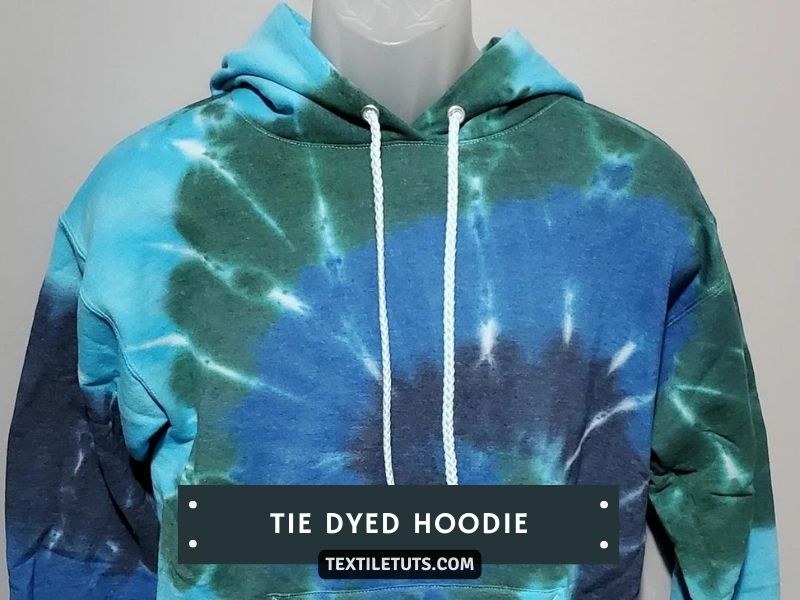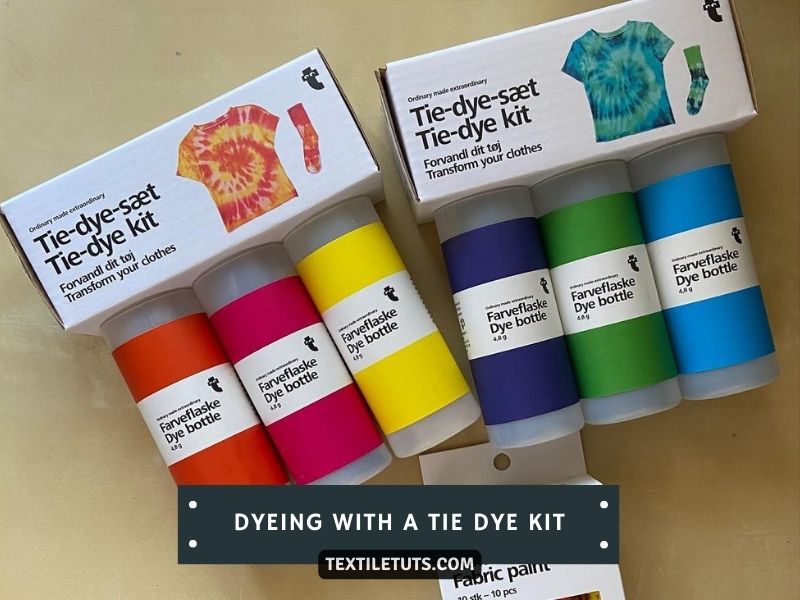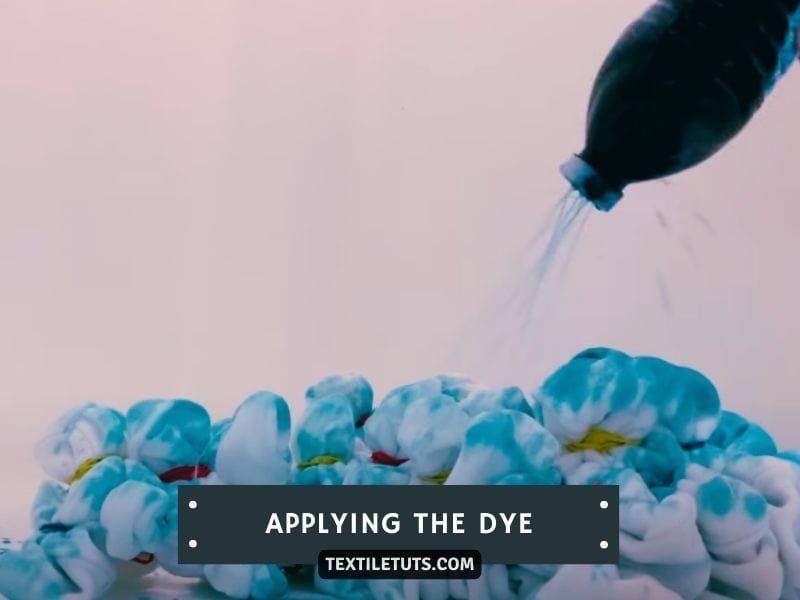Why Don’t We Tie Dye Hoodie?
Tie dye is a fun and easy way to add some color to your wardrobe. Hoodies are comfortable and stylish, making them an excellent choice for a tie dye project. But despite the new style option and creative fun experience, why don’t we tie dye hoodies?
Because it’s a lot of work and can be difficult to get the tie-dye evenly distributed on the fabric. If you don’t have a lot of experience with tie-dye, it’s easy to end up with an uneven or blotchy design. In addition, it’s a messy, hard to control, and time-consuming process.
In this blog, I will explain why people don’t tie dye their dresses anymore and provide a few guidelines on how to tie dye a hoodie so you can make your one-of-a-kind creation. Let’s get started!
Why Don’t People Tie-Dye Hoodies?

Tie-dyeing a hoodie is a great option for a unique design in your dress. The results can be eye-catching, and you’ll be the only one around with a hoodie like it. But people don’t do it often and it’s not a trend. There are a few reasons why people may not want to tie-dye their hoodies.
Hoodies Are Not a Good Option
Hoodies are just not as popular as other garments for this project. Tie-dyeing is not particularly necessary for hoodies, as they are typically already brightly colored or patterned.
Hoodies are made of a different fabric and are much more expensive than traditional tie-dye shirts. They are made of a polyester blend, which doesn’t take well to dye. Also, these are harder to tie-dye because of their shape.
Long Procedure
The process may seem daunting or complicated. It can be a lot of work. Others may feel that tie-dyeing is not worth the effort, as the results can be unpredictable.
Time-Consuming Process
You must soak the fabric in water, apply the dye, and let it dry. It can be time-consuming to let the dye set. It is a messy process, and it’s easy to make a mistake. It’s possible to end up with dye on your hands, clothes, and surfaces.
Needs Skill
When dyeing fabric, it is tricky to get the desired results. So some people may be discouraged by past experiences. Also, getting the dye evenly distributed can be difficult, as the results are unpredictable. Finally, some people do not like how their hoodie looks after it’s been tie-dyed.
Permanent Design
This dying process is pretty permanent. Once you’ve dyed a hoodie, you’ll not likely be able to change the color or pattern. This can be a bit of a commitment, as it’s not easy to undo once it’s been done. So if you’re not sure you want a tie-dye hoodie, it’s better not to do it.
Not Everyone Likes It
Some people simply don’t like the way tie-dye pattern looks. It can be pretty psychedelic, and not everyone is into that aesthetic. If you’re not sure you’ll enjoy how your hoodie looks after dying it, it’s probably not worth the effort.
Also, some people may believe that tie-dyed hoodies are juvenile or tacky. However, they often result in bold, bright colors that may not be to everyone’s taste.
Can You Tie Dye A Hoodie Using the Tie Dye Kit?

Yes! You can tie-dye a hoodie all your own without needing anyone’s help. You can use a dye kit and put some colorful designs in your plain white hoodie. It can be a fun project for you, and all the necessary things can be found at most craft stores.
Tying a dye hoodie is not overly complicated, and the process is similar to tying a dyed shirt. However, there are a few essential tips to keep in mind to ensure that your hoodie turns out looking great. But before you decide and proceed with any dying process, keep these facts in mind.
Choose the Right Hoodie

Not all fabrics are created equal when it comes to tie-dyeing. Natural fibers like cotton and linen work best, as they’re more absorbent and hold the dye better than synthetic fabrics.
This will allow the dye to take to the fabric better and result in a more vibrant finished product. Avoid hoodies with many blended fabrics or synthetic materials, as the dye may not adhere well to these materials. Any color or style will work, but remember that lighter colors will show the dye more than darker colors.
Prepare Your Fabric
Before you start tie-dyeing, it’s essential to wash your fabric to remove any dirt or oils that could prevent the dye from penetrating evenly.
You can either wash your fabric in your washing machine using hot water or pre-soak it in a solution of warm water and laundry detergent. Once your fabric is clean, dampen it with clean water, so it’s damp but not soaking wet.
Choose Your Dye

You can use any type of dye, but fabric dye or tie dye kit will work best. You’ll need to choose your fabric dye. All sorts of different dyes are available, so take some time to experiment and find one you like.
Decide on Your Design
There are endless possibilities when it comes to tie-dyeing, so take some time to sketch out your design beforehand. This will help you determine how much dye you need and which colors to use.
There are a few different ways to tie a hoodie for dyeing. The most important thing is to create tight knots so that the dye doesn’t bleed through to the other side of the fabric. Be as creative as you want with the rubber bands. You can make swirls, stripes, or any different design that you can think.
Set Up Your Work Area
Cover your work surface with a plastic tablecloth or garbage bag to protect it from dye spills. You can either spray the dye or submerge the hoodie (depending on your dyeing style).
How Do You Tie Dye Hoodies?
With a tie dye kit, you can quickly transform a plain hoodie into a work of art. The process of tie-dyeing a hoodie is similar to tie-dyeing any other piece of clothing. Follow these steps, and you’ll be on your way to creating a one-of-a-kind, tie-dye masterpiece! The first thing you need to do is gather your supplies.
You’ll need:
- A white or light colored hoodie
- Bottle of tie dye in your desired color or tie dye kit
- Pair of rubber gloves
- Rubber Bands
- Plastic bag
- Bucket
- Scissors
Step 1: Put Your Gloves On
Start by putting on your gloves. These will protect your hands from the dye. Next, cover the area you will work on using the plastic bag. This will also protect the site from the dye.
Step 2: Wet the Hoodie
To start, wet your hoodie in the sink and wring it out so it’s damp but not dripping wet. Then, lay it flat on a surface you don’t mind getting messy.
Step 3: Set up the Work Space
Find a suitable workspace. Set up a plastic tablecloth or old newspapers to protect the surface from dye stains. It’s also a good idea to wear old clothes or an apron to avoid staining your own clothing.
Step 4: Decide on the Tie-Dye Pattern

Decide on the tie-dye pattern you want. There are several patterns to choose from, including spiral, bullseye, crumple, or stripes. The tie-dye kit usually provides instructions for creating each pattern, so refer to those if needed.
Step 5: Twist or Fold to Secure the Fabric

Once you’ve decided on the pattern, gather sections of the hoodie and twist or fold them to create the desired effect. Use rubber bands to secure the fabric so that the dye does not penetrate those areas. You can create multiple twists and folds for different color sections, or you can leave certain areas untouched for a white or non-dyed effect.
Step 6: Put on Gloves and Open the Kit
Put on gloves to protect your hands from getting stained and open the tie-dye kit. Depending on the kit, you may need to mix the powdered dye with water or simply use the pre-mixed liquid dyes.
Step 7: Apply the Dye

Carefully apply the dye onto the hoodie, making sure to saturate the fabric thoroughly. You can use a squeeze bottle, spray bottle, or even your gloved hands to apply the dye.
Step 8: Wrap the Hoodie and Let the Dye Set
Once the dye is applied, place the hoodie in a large plastic bag or wrap it in plastic wrap. This will help keep the fabric moist and allow the dye to set properly. Depending on the type of dye used, the instructions in the tie-dye kit will specify the required time for the dye to set.
Step 9: Rinse the Hoodie
After the recommended amount of time, carefully remove the hoodie from the bag or plastic wrap. Rinse the hoodie under cold water, gradually removing the excess dye until the water runs clear. Continue rinsing until most of the excess dye has been removed.
Step 10: Remove Rubber Bands and Air Dry
Finally, remove the rubber bands and unfold the hoodie to reveal your tie-dye masterpiece! Hang it up to air dry, preferably in a shaded area, to ensure the colors do not fade in direct sunlight.
NOTE
Remember to always follow the specific instructions provided in the tie-dye kit you use, as different kits may have slightly different techniques or dye setting times. Have fun experimenting with different colors and patterns to make unique tie-dye hoodies that reflect your personal style!
Why Is Tie Dye Making a Comeback?
Tie dye was once a popular trend in the 1960s and 1970s. However, the truth is that the history of tie dye goes back much further. Tie dye originated in Asia and has been used for centuries to add color to the fabric.
It was once a popular craft among hippies and bohemians, but in recent years, it has come back with a new generation of crafters.
There are a few reasons why tie dye is making a comeback. First, this DIY trend is easy to do at home, and it’s a fun way to add some color to your wardrobe.
Inexpensive Way to Unique Design
It’s a relatively inexpensive way to add some personality to your clothes. If you’re tired of wearing the same old thing, tie dye is a great way to spice up your look without breaking the bank.
Retro Style
This is now considered a retro craft, and there is a growing interest in all things retro. In addition, this design provides a nostalgic appeal. Many people who are now in their 20s and 30s grew up wearing tie dye; they’re now looking to revisit that part of their childhood.
DIY Friendly and Easy to Learn
Tie dye is a very versatile craft. This can be worn casually or dressy, depending on how you style. It can be used to create a wide variety of patterns and can use on various fabrics. This is also a relatively easy craft to learn and can be a lot of fun.
Celebrities Are Wearing Them
The resurgence of tie dye can be traced back to the early 2000s when fashion designers began incorporating it into their collections. Celebrities like Gwen Stefani and Nicole Richie. In recent times Kendall Jenner and Bella Hadid have also been spotted wearing tie dye, and the trend soon caught on with the general public.
Designers Making Products
Tie dye is having a moment in fashion, especially for summer and spring products. High-end designers like Marc Jacobs and Vogue have incorporated it into their collections.
Easy Process to Reuse Old Dress
It’s a great way to upcycle old clothes you might otherwise get rid of. And tie dye can be a very personal and meaningful process, as it’s often seen as a symbol of peace and love.
What Are the Best Tie-Dye Patterns?
With so many different tie-dye patterns, it can be hard to choose which one is right for you. Here are some of the best tie-dye patterns to help you make your decision:
Spiral
One of the most popular and classic tie-dye patterns is the spiral. To create a spiral pattern, start by folding the fabric in half and then in half again. Next, tie a rubber band around the center of the fabric to create a small hole. Then, working from the center, twist the fabric into a spiral. Once you reach the end, tie another rubber band around the fabric to secure it.
After tie, you can start dying your dress. The final result is a beautiful spiral pattern that looks great on any fabric.
Bullseye
The bullseye pattern is another classic tie-dye design. To create this pattern, you need to fold your fabric into a circle and then tie it off in the middle. Once you’ve done that, you can apply the dye.
Chevron
The chevron pattern is a bit more complicated than the other two, but it’s worth it. To create this pattern, you need to fold your fabric into a zig-zag shape and tie it off in several places. After the dying process, the final result is a chevron pattern that looks great on bed sheets.
Crumple
The crumple pattern is another excellent option for tie-dye. To create this pattern, you must crumple your fabric into a ball and tie it off in several places. Once you’ve done that, you can start applying your dye.
Abstract
If you’re looking for a more abstract pattern, then the abstract way is definitely for you. To create this pattern, you must tie your fabric off in several places you wish. Tie anywhere you want to make any pattern.
Stripes
Fold the fabric half lengthwise and tie a rubber band around the center. Then, fold the fabric in half again and tie another rubber band around the center. Continue folding and tying rubber bands until you have as many stripes as you want.
Circle
To create a circle pattern, fold the fabric in half and then in half again. Then, tie a rubber band around the center of the fabric to make a small hole.
Now, twist the fabric into a spiral from the center. Tie another rubber band around the fabric to secure it once you reach the end.
Do Tie Dye Shirts Eventually Lose Their Color?
Most tie dye shirts will eventually lose their color over time. This is due to the nature of the dyes used in tie-dying. These dyes are not colorfast, meaning they will eventually fade when exposed to sunlight or other light sources.
However, you can do a few things to help slow down this process and keep your tie dye looking vibrant for as long as possible.
Don’t Wash in Hot Water
Avoid washing your tie dye in hot water; stick to cold or lukewarm water instead. Hot water will cause the colors to bleed and run, making them appear duller and less vibrant.
Don’t Use Harsh Detergent
Don’t use bleach or other harsh chemicals on your dress; these can also cause the colors to fade.
Air Dry Your Dress
Hang your shirts to dry instead of putting them in the dryer; the heat from the dryer will cause the colors to fade as well. Also, avoid exposing your shirt to direct sunlight. UV rays will cause the colors to fade over time.
Can We Tie Dye Hoodies Using Bleach Instead of Dyes?
Using bleach to tie dye hoodies is often seen as an unconventional method as it’s not as widely used as traditional tie dyeing with dyes. Bleach tie dye technique may not work for a variety of reasons. Firstly, the bleach may not achieve the desired effect on the fabric of the hoodie. Secondly, the bleach may not be able to penetrate the fibers of the fabric, resulting in an uneven and muted color effect.
In addition, the bleach may cause the fabric to weaken and disintegrate in some areas, leading to further problems.
Overall, while the bleach tie dye technique may seem like a viable option, it can be difficult to achieve the desired outcome on a hoodie.
Can You Successfully Tie Dye a Hoodie Made of 50% Cotton and 50% Polyester?
Creating vibrant patterns on a mixed-fabric hoodie can be tricky. To tie dye 50 cotton 50 polyester hoodies, the cotton fibers absorb dye well, while polyester resists it. This mix results in softer, muted colors rather than bold hues. Pre-washing and using quality dyes can enhance your tie-dye success.
Conclusion
While some people may enjoy the unique look of a tie dye hoodie, others may not find the style appealing. In addition, it can be a bit of a messy process, and not everyone is up for that.
As a time-consuming, complex process, getting the perfect design is not always possible. Additionally, these dresses may require more care when washing than plain hoodies.
Despite these reasons, tie dyeing hoodies are a fun activity that more people should try! It’s a great way to add personality to your wardrobe and show off your creative side.
